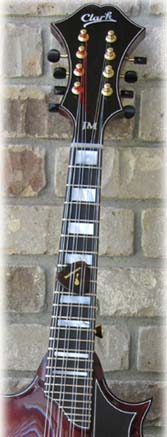« Pete Martin: Bebop Mandolin; Target Notes and Chromatic Approaches |
Main
| Art imitates life; Impressionist Painters and Jazz Music »
 November 18, 2010 | Closing it up November 18, 2010 | Closing it up
 We invest a lot energies here discussing the benefits of learning closed position fingering. The approach is quite practical, and benefits almost immediate. Better advantages increase exponential over time too, as you become more fluent and move up the neck. We invest a lot energies here discussing the benefits of learning closed position fingering. The approach is quite practical, and benefits almost immediate. Better advantages increase exponential over time too, as you become more fluent and move up the neck.
Resistance by many may be because of the extra use of the pinky finger, and some frankly don't understand why being able to play in Ab or Eb is somehow relevant to their particular music genre tastes, but a reliance on open strings can be limiting to most, and crippling to some. What the FFcP system does is develop recognizable patterns of one and two fret intervals. In the case of the Major Scale, you have a two fret, two fret, one fret pattern of skips that conveniently repeats itself on the next string. That's the 1st FFcP in a nutshell, based on starting with the first finger. Learning the other three patterns, 2nd FFcP, 3rd FFcP, and 4th FFcP, starting on the respective fingers is a scheme of organizing the similar one fret/two fret patterns in an intuitive and tactile way. Once these are established, you have incredible liberty and movability at your literal fingertips.
Do we ignore the open strings?
Yes, but only temporarily, and just in the early orientation stage. The goal is to add the closed finger approach to your arsenal of mandolin tools, not to replace it. Sure that open A string is handy to fall back on, but if you never fret the A note on the 7th fret of the D string, you're never uncovering the instruments verdant potential in the upper register, or the ergonomic fingerings of moving into 3rd, 5th or 7th position. The FFcP pattern drills are the calisthenics that allow you to play the game.
If you haven't already, check out the first lesson on our FFcP index page. If you have been exposed to it, explore some of the other more advanced versions, including Dorian/Minor, Pentatonic, and 7th chord arpeggios.
Your playing will never be the same.
Further:
Paths to fretboard mastery
"The notes seem to come from out of nowhere."
Let's review. Why Closed Fingerings again?
Math, eggs, and mandolins; higher level understanding
Closed Fingerings
Posted by Ted at November 18, 2010 12:29 PM

Disclaimer: In the 'Information Age' of the 21st Century,
any fool with a computer, a modem, and an idea can
become a self-professed 'expert." This site does not
come equipped with 'discernment.'
|



